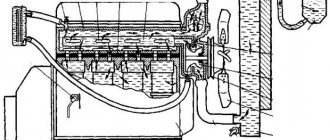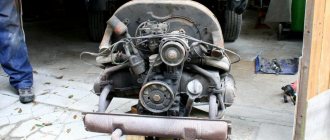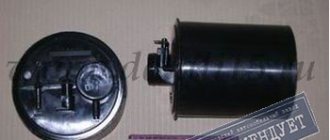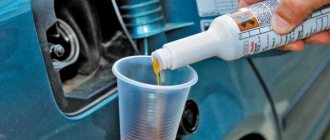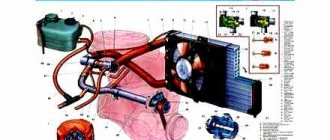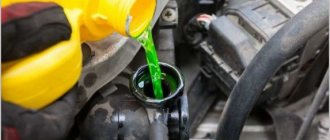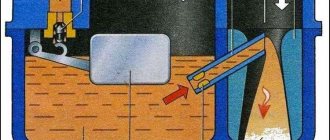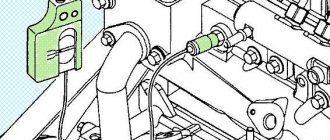Cooling system flush frequency
There are no clear rules written down anywhere. But you need to take into account that in a working car - a car, a truck, mixing of oil and antifreeze does not occur - the 2 fluids are sealed and function separately.
But sometimes oil gets into the cooling system (it’s a breakdown or the owner accidentally filled it in - it doesn’t matter) and you need to urgently take the necessary actions to fix the problem. If ignored, the situation will lead to the following consequences:
- wear of bearings, since parts are negatively affected by an aggressive environment;
- risk of diesel engine jamming, water penetrates the cylinders and causes water hammer;
- contamination of the main line and pipes of the cooling system, as a result of which the latter ceases to function.
Non-working cleaning methods
When faced with the problem of oil getting into the car’s cooling system, drivers at home resort to different cleaning methods. But not all options are effective.
For example, they clean with “Whiteness”. But few people know that the product contains chlorine, which causes corrosion of aluminum components (and the radiator of most cars is made of this metal). In addition, “Whiteness” is not capable of properly cleaning the system, but will only cause damage.
Another option is baking soda. It effectively removes rust and scale deposits, but cannot fight oily deposits.
Effective folk remedies
There are also effective means, and many of them are available to almost everyone and are available in any home. But before using such methods, it is worth assessing the scale of the problem and, if possible, it is better to trust the specialists.
Milk serum
Whey is one of the effective folk methods. But some consider its effect exaggerated. However, the method is popular:
- Before use, the serum is filtered through a gauze bandage to remove existing sediment and clots.
- Liquid is added to the system and driven like this for 150-200 km. Some people simply warm up the engine and then drain the serum. If clots and oily deposits are observed, the procedure is repeated.
Coca Cola
Coca-Cola is not only a cooling drink. It is used to clean scale from dishes and electric kettles.
Many people recommend using Cola (or Sprite) as a cleanser against oil in the radiator. But you should be careful here, since this method of flushing the system is suitable for copper or brass parts. If a thin aluminum alloy is used, the liquid will not only not remove traces of oil, but will make holes in the walls and pipes, which will require repairs.
Lemon acid
To carry out cleaning you need:
- Dissolve 500-1000 g (depending on the contamination) of citric acid in 10 liters of water.
- Pour into the car radiator.
- Start the engine for 20-25 minutes.
- Disconnect and wait about 1 hour.
- Drain the dirty liquid and rinse with running water.
Fairy for dishes
Any detergent will do, but car enthusiasts recommend Fairy as the most effective and proven.
To clean the cooling system from oil deposits, you will need:
- Pour 200-250 ml of Fairy into water (the quantity is not important, it depends on the contamination of the system) and stir.
- Pour the resulting liquid into the expansion tank.
- Start the engine, wait for the filled liquid to boil, and then simply drain it. Repeat this until the system is cleared of oil, then rinse with running water until the foam completely disappears.
With this method, it is taken into account that Fairy produces a lot of foam. Therefore, when carrying out the procedure, it is worth monitoring the condition of the expansion tank.
Some drivers do not drain the solution, but try to drive 100-150 km this way. Afterwards, water is poured into the radiator and the system is completely cleaned.
Distilled water
Purified water is also considered an effective remedy if the purification procedure is carried out repeatedly.
So, how to flush the engine cooling system:
- Pour water into the expansion tank.
- Start the engine and heat the water to a temperature of 90°C.
- By pressing the gas pedal, the driver can observe how oil deposits are pushed out. This procedure is repeated 5-6 times, after which the system is considered cleared of contamination.
Precautions and washing nuances
When washing yourself, it is best to use special products that are selected depending on the contamination (oil, scale, rust). The use of most traditional methods will not be as effective as the use of special liquids.
Please note that folk remedies are not always cheaper than special ones. In addition, their application takes longer. For example, to clean the system from foam after using dishwashing detergent, you will need to rinse it at least 10 times.
To flush the engine using any means, you must use distilled or boiled water. If you take tap water, scale will form during heating.
There are many ways to flush the cooling system if oil gets into it. Each of them has its own advantages and disadvantages. In order to prevent serious consequences, it is necessary to periodically monitor the condition of the antifreeze and, when the first signs of oil getting into it appear, eliminate the causes and flush the system.
Special means
When cleaning the cooling system from oil impurities, specially developed products are also used. Russian drivers have several effective options available to them.
ABRO AB-505 is considered popular. The drug fights limescale, rust, and removes oil stains well.
The full volume of liquid (standard 0.354 l) is poured into a system already filled with water. Start the engine for 30 minutes, with the car running at idle. Afterwards the engine is turned off and the liquid is removed. Then turn on the ignition again and, with the radiator drain hole open, constantly add water until the system is cleared of oil impurities and the water becomes clear.
An effective option is LIQUI MOLY Kuhlerreiniger. The developers assure that the product removes scale and various contaminants, including removing oil impurities. Additionally, the drug neutralizes acid and thick lubricants. And since there are no aggressive substances in the composition, it can be used with every fluid change. The product is also neutral towards plastic, rubber and metal.
To clean the tank of oil impurities, 1 package of the drug is diluted in 10 liters of antifreeze and poured into the radiator. Then they start the engine and wait 20-25 minutes. Turn off the engine, wait 3-4 hours and remove the contaminated antifreeze. The expansion tank is washed with running water. All that remains is to fill in the new solution.
Another effective product (sold in 2 bottles), according to reviews from car enthusiasts, is LAVR. The drug is designed to act in 2 stages, completely cleaning the cooling system. LAVR is capable of removing even heavy soiling.
The cleaning procedure is as follows:
- Antifreeze is completely removed from the cooling system; instead, a bottle is poured into the expansion tank to remove rust and scale. Afterwards, the system is filled to the minimum level with distilled (or at least boiled) water. Next, the engine starts and remains idling for half an hour (regardless of whether it is an automatic transmission or a manual transmission). Afterwards, the contaminated liquid is completely drained.
- Oil-emulsion deposit cleaner from 2 packages is poured into the empty radiator (after draining the liquid from 1 bottle). The system is filled with distilled water to the minimum level. Turn on the engine at idle speed for 30-40 minutes. At the end, the solution is drained, clean water is introduced into the system, the motor runs for another quarter of an hour, then the tap is opened to drain. This is repeated until clean, transparent liquid begins to flow from the tank. All that remains is to fill in new antifreeze.
Additionally, for minor contamination, drivers can use other flushing products from the LAVR line.
This includes:
- classic (Classic) liquid;
- for commercial vehicles (Fortrucks);
- synthetic (Syntetic) solution.
In addition, products from others are also offered: Bizol, Liquid Moly, Pingo. The preparations are tested, so they remove contaminants without harming the cooling system and its components.
How to flush the engine from emulsion, dirt and deposits
It is quite obvious that if you need to wash the engine from the inside, then you need a good engine flush. There are a large number of different formulations on sale.
In practice, all products can be divided into two groups:
However, choosing the best engine flush product is not so easy. First of all, you need to proceed from the specific situation. If you just need to flush the lubrication system before changing the oil, and we are not talking about removing remnants of an emulsion or counterfeit product, then a regular “five-minute” may be quite enough.
It should also be remembered that quick flushes in oil can also have a negative effect on gaskets, seals and other seals. There have been cases where, after applying oil flushes, the engine began to leak.
- In case of more serious contamination, it is better to use ready-made flushing oils, which are poured into the engine in full instead of base oil. Depending on the type of flushing composition, the unit should either operate only at idle speed, or short-term driving with minimal loads on the internal combustion engine is allowed.
This type of washing is less aggressive to rubber seals compared to “five-minute” ones, and also more thoroughly washes away dirt and deposits. We also note that flushing oils can be synthetic, semi-synthetic or mineral, and are also universal. In other words, they can be used in both gasoline and diesel internal combustion engines.
In practice, this solution can be considered optimal for flushing the engine from emulsion after antifreeze or antifreeze gets into the lubrication system. Flushing oils are also better suited for cleaning dirty internal combustion engines with high mileage.
At the same time, the risk of “clogging” the channels and filters (for example, in hydraulic compensators, the oil receiver mesh) with soggy dirt is still present, but it is not as high as compared to a quick rinse in engine oil.
Which way is better?
There are many ways to clean the system with your own hands, but none of them can be considered universal. It all depends on the contamination of the radiator with oil deposits and the material from which the expansion tank and other parts are made.
It is recommended to buy products at car dealerships or special places (for example, service stations). As for traditional methods, when using the same Coca-Cola, you cannot be sure of the quality of cleaning. In addition, if the radiator material is unknown or the person is inexperienced, then you may have to buy a new cooling system, including a thermostat.
For example, many carbonated drinks contain phosphoric acid. It easily corrodes the pipes, and this is an additional expense. It must be taken into account that you should work with any substance carefully, because even if you exclude the risk of damage to car parts, you can get burned yourself.
Experts pay attention to the point that even after cleaning the system with professional means and thorough rinsing, an oil film remains. The radiator is considered cleaned, but it is possible to completely get rid of contaminants and wash out the oil only if the tank is desoldered.
Therefore, despite the purchased preparations and cleaning methods, in case of severe contamination it is often advised to prepare for a complete replacement of all parts of the system. Only timely repairs and car care will keep your vehicle in good condition.
ICE cleaning options
Today, car power units are cleaned of old grease in various ways.
Five minute rinse
This product is poured into the engine immediately before changing the engine oil, mixed with the “working off”. After this, the internal combustion engine is started, idling for 5-10 minutes. This is followed by the traditional draining of the used composition, changing the filter and injecting new lubricant.
Flushing oil
Here, a specialized motor lubricant is used, which is poured in after removing the used composition. The engine runs for some time with this oil at idle speed, after which the substance is changed to fresh motor oil and the filter is cleaned.
Flushings with which they travel
This option allows you to travel a certain distance with the cleaning agent. A special substance is added to the old lubricant about a hundred kilometers before the next oil change, and until that moment I operate the car correctly and carefully. When it comes time for maintenance, the engine oil is changed according to the standard procedure.
Extra grease
This option is recommended for use when changing the lubricant to a composition with a different base, or for flushing very dirty engines. First, you should drain the used lubricant and pour in the composition that will be used in the subsequent operation of the car.
The amount of fresh oil can reach only a couple of liters. The engine idles for a short time. After this, all the lubricant is changed back to fresh, and a new filter is installed.
